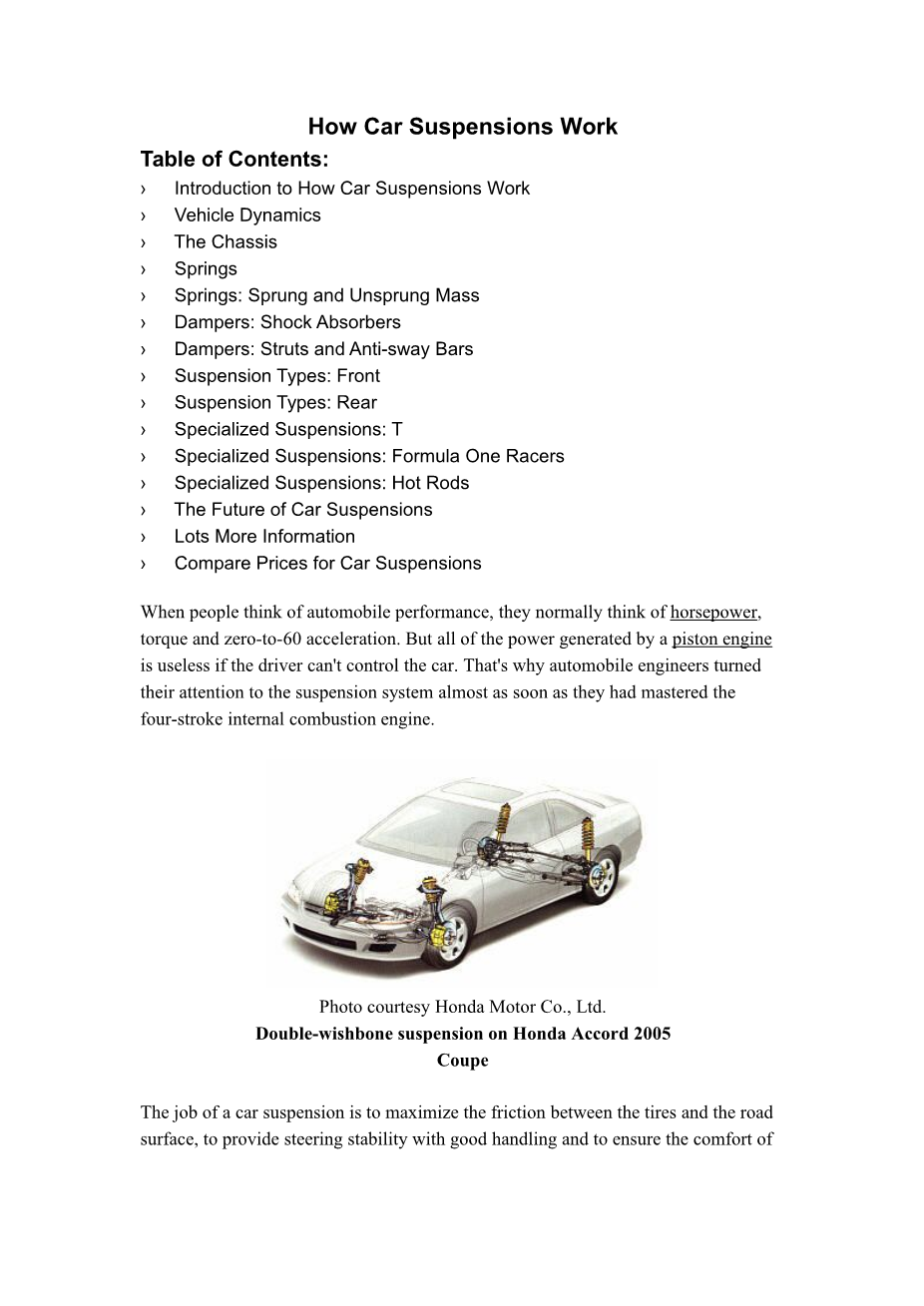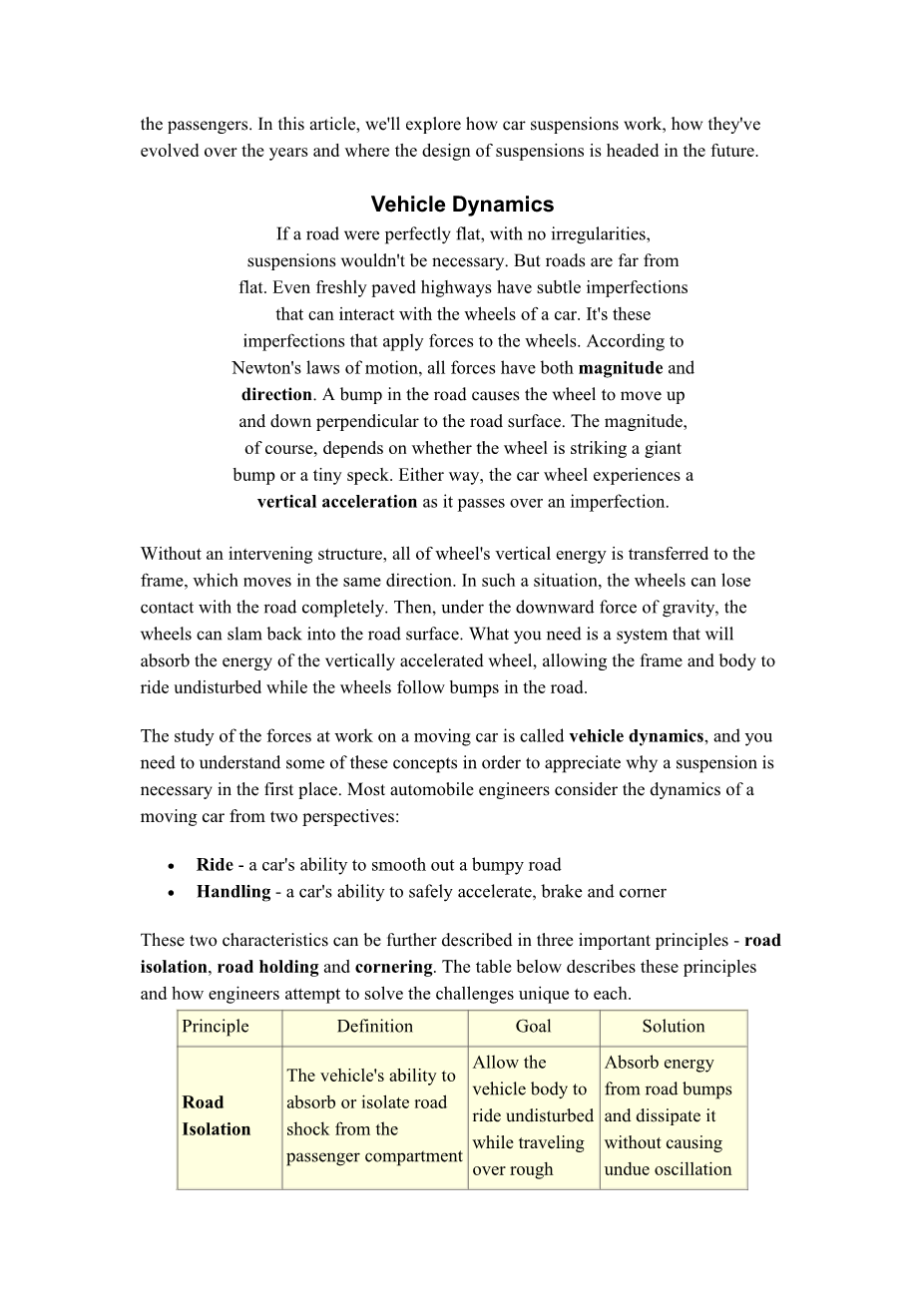汽车悬挂系统是如何工作的外文翻译资料
2023-01-31 11:35:41


英语原文共 13 页,剩余内容已隐藏,支付完成后下载完整资料
How Car Suspensions Work
Table of Contents:
rsaquo; Introduction to How Car Suspensions Work
rsaquo; Vehicle Dynamics
rsaquo; The Chassis
rsaquo; Springs
rsaquo; Springs: Sprung and Unsprung Mass
rsaquo; Dampers: Shock Absorbers
rsaquo; Dampers: Struts and Anti-sway Bars
rsaquo; Suspension Types: Front
rsaquo; Suspension Types: Rear
rsaquo; Specialized Suspensions: T
rsaquo; Specialized Suspensions: Formula One Racers
rsaquo; Specialized Suspensions: Hot Rods
rsaquo; The Future of Car Suspensions
rsaquo; Lots More Information
rsaquo; Compare Prices for Car Suspensions
When people think of automobile performance, they normally think of horsepower, torque and zero-to-60 acceleration. But all of the power generated by a piston engine is useless if the driver cant control the car. Thats why automobile engineers turned their attention to the suspension system almost as soon as they had mastered the four-stroke internal combustion engine.
|
|
The job of a car suspension is to maximize the friction between the tires and the road surface, to provide steering stability with good handling and to ensure the comfort of the passengers. In this article, well explore how car suspensions work, how theyve evolved over the years and where the design of suspensions is headed in the future.
|
Vehicle Dynamics |
Without an intervening structure, all of wheels vertical energy is transferred to the frame, which moves in the same direction. In such a situation, the wheels can lose contact with the road completely. Then, under the downward force of gravity, the wheels can slam back into the road surface. What you need is a system that will absorb the energy of the vertically accelerated wheel, allowing the frame and body to ride undisturbed while the wheels follow bumps in the road.
The study of the forces at work on a moving car is called vehicle dynamics, and you need to understand some of these concepts in order to appreciate why a suspension is necessary in the first place. Most automobile engineers consider the dynamics of a moving car from two perspectives:
- Ride - a cars ability to smooth out a bumpy road
- Handling - a cars ability to safely accelerate, brake and corner
These two characteristics can be further described in three important principles - road isolation, road holding and cornering. The table below describes these principles and how engineers attempt to solve the challenges unique to each.
|
Principle |
Definition |
Goal |
Solution |
|
Road Isolation |
The vehicles ability to absorb or isolate road shock from the passenger compartment |
Allow the vehicle body to ride undisturbed while traveling over rough roads. |
Absorb energy from road bumps and dissipate it without causing undue oscillation in the vehicle. |
|
Road Holding |
The degree to which a car maintains contact with the road surface in various types of directional changes and in a straight line (Example: The weight of a car will shift from the rear tires to the front tires during braking. Because the nose of the car dips toward the road, this type of motion is known as 'dive.' The opposite effect -- 'squat' -- occurs during acceleration, which shifts the weight of the car from the front tires to the back.) |
Keep the tires in contact with the ground, because it is the friction between the tires and the road that affects a vehicles ability to steer, brake and accelerate. |
Minimize the transfer of vehicle weight from side to side and front to back, as this transfer of weight reduces the tires grip on the road. |
|
Cornering |
The ability of a vehicle to travel a curved path |
Minimize body roll, which occurs as centrifugal force pushes outward on a cars center of gravity while cornering, raising one side of the vehicle and lowering the opposite side. |
Transfer the weight of the car during cornering from the high side of the vehicle to the low side. |
A cars suspension, with its various components, provides all of the solutions described.
Lets look at the parts of a typical suspension, working from the bigger picture of the chassis down to the individual components that make up the suspension proper.
The Chassis
The suspension of a car is actually part of the chassis, which comprises all of the important systems located beneath the cars body.
|
|
These systems include:
-
The frame - structural, load-carryin
剩余内容已隐藏,支付完成后下载完整资料
资料编号:[149916],资料为PDF文档或Word文档,PDF文档可免费转换为Word




